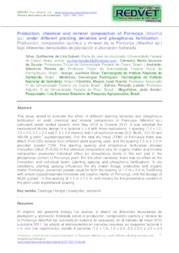Production, chemical and mineral composition of Pornunça (Manihot sp.) under different planting densities and phosphorus fertilization.
Production, chemical and mineral composition of Pornunça (Manihot sp.) under different planting densities and phosphorus fertilization.
Author(s): SILVA, G. de L. S.; CARNEIRO, M. S. de S.; ANDRADE, A. P. de; ARAÚJO, J. S.; MEDEIROS, G. M.; CÂNDIDO, M. J. D.; EDVAN, R. L.; MAGALHÃES, J. A.
Summary: This study aimed to evaluate the effect of different planting densities and phosphorus fertilization on yield, chemical and mineral composition of Pornunça (Manihot sp.) cultivated under rainfed system, from May 2010 to October 2011. It was adopted the randomized blocks design in a factorial 4 x 4 with three replications, 4 spacing (1.5 x 1.5, 1.5 x 2.0, 2.0 x 2.0 and 2, 5 x 2.0 meters) and 4 phosphorus levels (0.0, 56.66, 113.32 and 169.98 g plant-1 superphosphate). For the total dry mass (TDM) of Pornunça there was effect (P=0.023) isolated from different plant spacing used, and the spacing 1.5 m x 2.0 m provided greater TDM. The planting spacing and phosphorus fertilization showed interaction effect (P<0.05) in the chemical composition only for organic matter and mineral composition presented individual effect for phosphorus levels in the soil and in the phosphorus content of Pornunça plant. For the other variables, there was no effect on the interaction and individual factor (planting spacing and phosphorus fertilization). In dry conditions, planting spacing influences the dry matter forage production and organic matter Pornunça, presented greater value for both the spacing of 1.5 m x 2.0 m. Fertilizing with simple superphosphate increases soil organic matter of Pornunça, until the dosage of 56.66 g plant-1 in the spacing of 1.5 m x 2.0 m, and linearly for the phosphorus content of the plant used regardlessof spacing.
Publication year: 2018
Types of publication: Journal article
Unit: Embrapa Mid-North
Observation
Some of Embrapa's publications are published as ePub files. To read them, use or download one of the following free software options to your computer or mobile device. Android: Google Play Books; IOS: iBooks; Windows and Linux: Calibre.
Access other publications
Access the Agricultural Research Database (BDPA) to consult Embrapa's full library collection and records.
Visit Embrapa Bookstore to purchase books and other publications sold by Embrapa.

